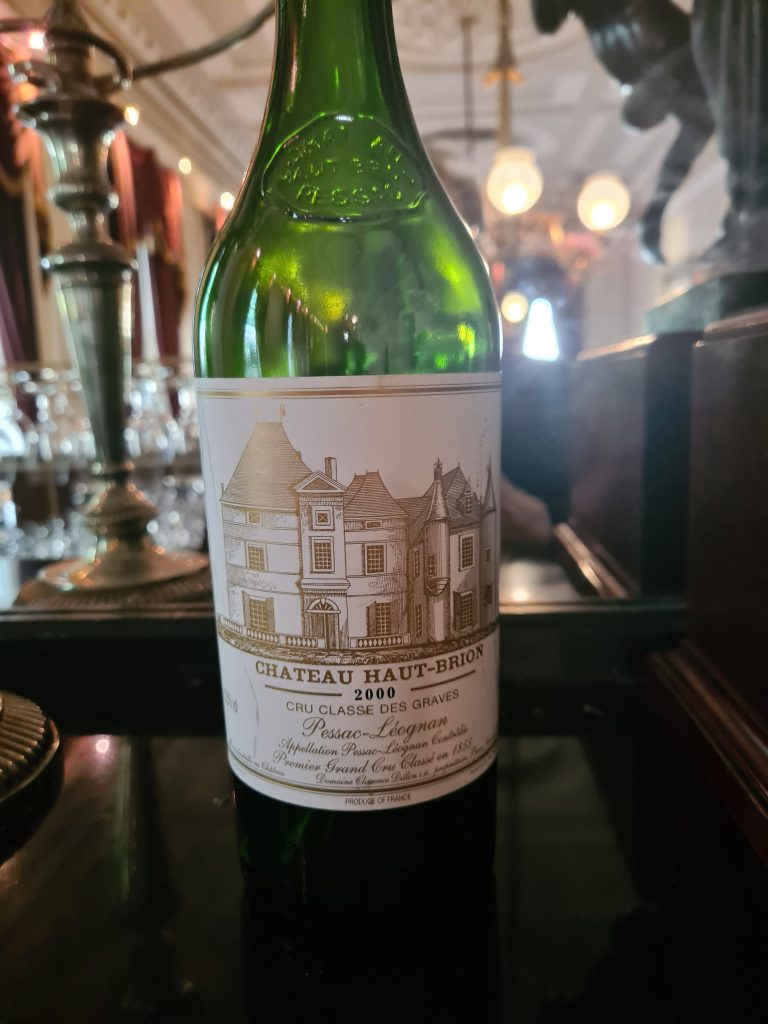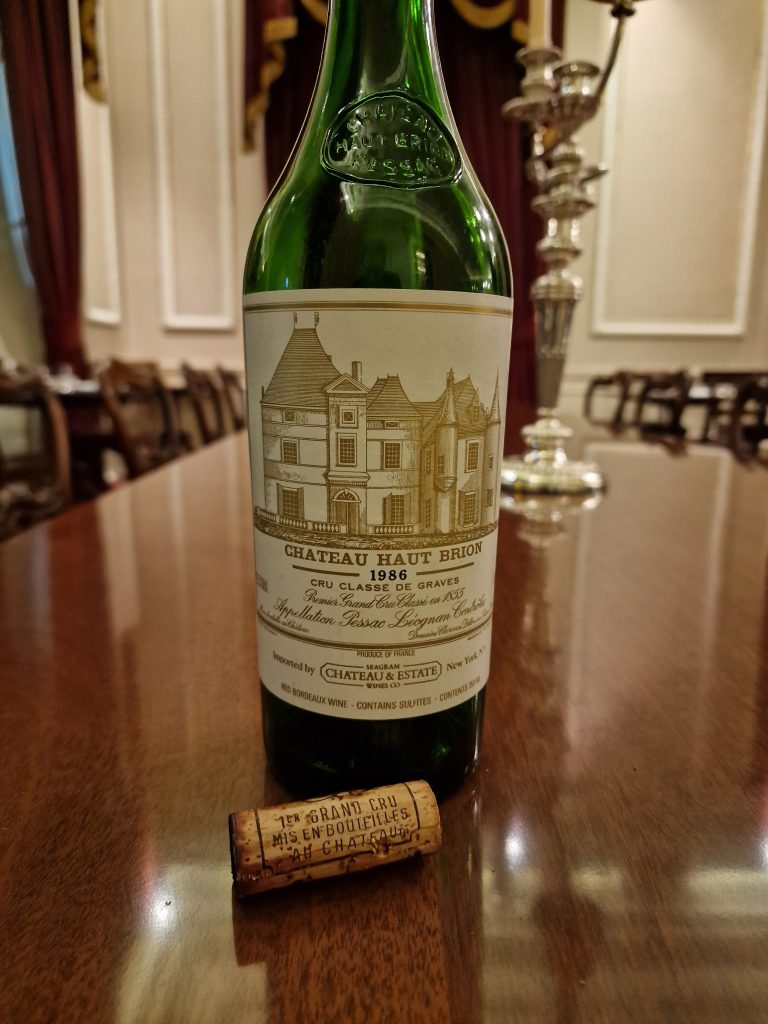In the world of fine wines, certain names evoke an air of reverence, a sense of history, and an enduring commitment to excellence. One such name is Château Haut-Brion, a French wine estate nestled in the heart of Bordeaux’s illustrious wine country. Revered as a Premier Grand Cru Classé, this vineyard, located just outside Bordeaux in Pessac, boasts a rich heritage that spans centuries. It is a name synonymous with prestige, quality, and a profound influence on the Bordeaux wine landscape.
Chateau Haut-Brion
135 Av. Jean Jaurès, 33608 Pessac | +33 556002930
www.haut-brion.com | Contact the Chateau
Chateau Haut-Brion on Google Maps
A Unique Terroir in the Graves Region
Château Haut-Brion distinguishes itself in more ways than one. Unlike its counterparts among the first growths of Bordeaux, Haut-Brion’s uniqueness is rooted in its geographic location. It calls the northern reaches of the Graves region home, making it the sole representative with the Pessac-Léognan appellation. This distinctiveness traces its lineage back to a classification system that remains the gold standard for Bordeaux wines today.
Beyond its prestigious grand vin, Haut-Brion is renowned for its red second wine, once known as Château Bahans Haut-Brion but rebranded as Le Clarence de Haut Brion starting with the 2007 vintage. The estate also produces a dry white wine named Château Haut-Brion Blanc, with a limited release of the second dry white wine, Les Plantiers du Haut-Brion, which was renamed La Clarté de Haut-Brion beginning with the 2008 vintage.
A Storied History
The history of Château Haut-Brion is a captivating tale that weaves through centuries. Though the precise origins of grape cultivation on this land can be traced back to Roman times, the earliest documented evidence of viticulture on this estate dates to the year 1423. The property passed through several hands before it found itself in the possession of Jean de Ségur in 1509, followed by Admiral Philippe de Chabot in 1525.
However, the true turning point in Haut-Brion’s history occurred in 1525 when Jean de Pontac married Jeanne de Bellon, the daughter of the mayor of Libourne and seigneur of Hault-Brion, who brought the land in her dowry. In 1533, he acquired the title to the domain of Haut-Brion, and construction of the château began in earnest in 1549.
The rise to prominence continued in 1649 when Lord Arnaud III de Pontac became the owner of Haut-Brion, and the wine’s popularity began to soar. The English King Charles II’s cellar ledger from 1660 bears the first recorded mention of Haut-Brion wine, with 169 bottles gracing the king’s court during 1660 and 1661. This marked the birth of a wine crafted specifically for the discerning English market.
Samuel Pepys, a prominent figure of the time, noted in his diary that he had tasted the “wine of Hobriono” in 1663, describing it as having a “good and most particular taste.” Pepys inadvertently provided the first tasting note for Haut-Brion.
The popularity of Haut-Brion among the English aristocracy led to its Anglicization as “Ho Bryen” and the creation of a wine that came from a small, distinguished area of land. Charles II’s cellar book and Pepys’ diary entry stand as historical proof of Haut-Brion’s special place in the world of wine.
In 1666, following the Great Fire of London, François-Auguste de Pontac, son of Lord Arnaud III de Pontac, opened a tavern in London called “L’Enseigne de Pontac,” becoming London’s first fashionable eating-house. This establishment introduced Haut-Brion to a broader audience.
The 17th century witnessed the expansion of the estate, with over 650 acres of land, including 94 acres of vineyards. The wine was often sold under the name “Pontac,” though this name was shared among several Pontac family estates.
Visiting Bordeaux in 1677, English philosopher John Locke described Haut-Brion’s vineyard as pure white sand, but thanks to the wealthy English who craved it, it became increasingly costly. The wine also captured the admiration of the German philosopher Hegel.
The passing of François-Auguste de Pontac led to the inheritance of Haut-Brion by François-Joseph de Fumel, with a portion also going to Louis-Arnaud Le Comte. The de Fumel family also owned Château Margaux.
In 1787, Thomas Jefferson, then the American minister to France, visited Haut-Brion and praised the terroir, classifying it among the top four estates of first quality. Jefferson also became one of the first Americans to import Haut-Brion to the United States, solidifying its reputation across the Atlantic.
The turbulent times of the French Revolution brought upheaval, resulting in the guillotine for Joseph de Fumel in 1794 and the division of his holdings. Eventually, in 1801, Haut-Brion found itself in the possession of Talleyrand, Prince of Benevento, who owned it for a brief three years.
A less prosperous period followed from 1804 to 1836 under various businessmen’s ownership until Joseph-Eugène Larrieu acquired Haut-Brion through an auction. Larrieu’s family retained ownership until 1923.
The 1855 classification, preceding the International Exhibition in Paris, elevated Château Haut-Brion to the rank of Premier Grand Cru, making it the sole representative from Graves among the three First Growths of the Médoc. Throughout the 19th century, Haut-Brion consistently commanded higher prices than other Bordeaux wines.
Modern Era and Ownership Changes
In the modern era, Château Haut-Brion experienced a series of ownership changes, with each proprietor leaving their unique mark on the estate.
In 1935, the American banker Clarence Dillon acquired Château Haut-Brion, marking a pivotal moment in its history. Clarence Dillon’s legacy lives on through the Domaine Clarence Dillon S.A.S. His nephew, Seymour Weller, took the helm of the Société Vinicole de la Gironde, a new company created for the purpose.
Under Weller’s leadership, significant improvements were made, including the restoration of the park, the modernization of vinification equipment, and the installation of electricity. Georges Delmas, who had served as the régisseur and director of Haut-Brion since 1921, continued to play a crucial role in maintaining the estate’s excellence.
Seymour Weller’s retirement in 1975 marked a transition in leadership, as Joan Dillon, Clarence Dillon’s cousin’s daughter, took the reins. In 1976, Haut-Brion made history by ranking fourth among French and California red wines in the “Judgment of Paris” wine competition.
The fierce rivalry between Haut-Brion and Château La Mission Haut-Brion, which had persisted for years, reached its culmination in the 1970s and early 1980s when Domaine Clarence Dillon acquired La Mission in 1983. This move brought two illustrious estates under a single banner.
In honor of the 75th anniversary of Dillon family ownership, the red second wine, Château Bahans Haut-Brion, was rebranded as Le Clarence de Haut-Brion starting with the 2007 vintage. Similarly, the white second wine, Les Plantiers du Haut-Brion, was renamed La Clarté de Haut-Brion with the 2009 vintage.
Jean-Bernard Delmas, who had succeeded Georges Delmas, retired in 2003, and his son, Jean-Philippe Delmas, took over as manager. Prince Robert of Luxembourg, the son of Prince Charles of Luxembourg, assumed the role of Président Directeur Général of Domaine Clarence Dillon in 2008.
Diving into the Terroir
Château Haut-Brion’s vineyard spans 48.35 hectares (119.5 acres) devoted to red grape varieties, including 45.4% Merlot, 43.9% Cabernet Sauvignon, 9.7% Cabernet Franc, and 1% Petit Verdot. An additional 2.87 hectares (7.1 acres) are dedicated to white grape varieties, comprising 52.6% Sémillon and 47.4% Sauvignon blanc.
The vineyards, with elevations reaching up to 27 meters, boast a unique soil composition of Günzian gravel, with some parcels featuring a higher clay content. All the vineyards are strategically located near the château itself and on the opposite side of the main road.
Château Haut-Brion’s commitment to excellence extends to its meticulous selection of rootstocks and clones. This pioneering effort, spearheaded by Jean-Bernard Delmas, significantly contributed to the vineyard’s plant material quality. The estate’s long-term goal is to reduce yields not through green-harvesting but by ensuring healthy and balanced vines. The average age of the vines is approximately 35 years, with some parcels dating back to the 1930s. The vine density averages 8000 vines per hectare.
Harvesting at Haut-Brion is a labor-intensive process conducted entirely by hand. Each parcel is meticulously tended to by the same team of workers, fostering familiarity with each vine. The white grapes are harvested early due to the proximity of the estate to Bordeaux, which results in a warmer microclimate and earlier ripening. The red grapes are harvested as late as possible, carefully sorted, and pneumatically pressed in whole bunches. The red grapes undergo fermentation in oak barrels with indigenous yeast. After field sorting, the red grapes are destemmed, crushed, and transferred to a unique double-tank system, where fermentation takes place in the top tank and malolactic fermentation occurs in the lower tank, leveraging gravity for movement. Aging for the grand vin previously took place in 100% new oak casks for 18 months, a practice that has been modified to 35% new casks. The wine intended for the second wine, Le Clarence, is aged in 25% new oak. The white wine is aged in 40-45% new oak for 10–12 months, and Château Haut-Brion even boasts its own cooperage.
Production and Legacy
Château Haut-Brion’s annual production of the red grand vin, Château Haut-Brion, ranges from 10,000 to 12,000 cases (900 to 1,080 hectoliters). The white grand vin, Château Haut-Brion Blanc, is produced in smaller quantities, totaling 650 to 850 cases (59 to 76 hectoliters). The estate’s red second wine, Le Clarence de Haut-Brion, formerly known as Château Bahans Haut-Brion, sees an annual production of 5,000 to 7,000 cases (450 to 630 hectoliters), while the white second wine, La Clarté de Haut-Brion, formerly Les Plantiers du Haut-Brion, is crafted in limited quantities, yielding 1,000 to 1,200 cases (90 to 108 hectoliters).
In conclusion, Château Haut-Brion is not just a wine estate; it is a living testament to the artistry and dedication that have shaped Bordeaux’s wine legacy. With a history that spans centuries, an unwavering commitment to quality, and a unique terroir that sets it apart, Haut-Brion remains a name that embodies the pinnacle of excellence in the world of wine. From its illustrious past to its modern innovations, Haut-Brion continues to be a beacon of excellence, a source of inspiration for wine enthusiasts and a testament to the enduring power of the vine. In the world of Bordeaux wines, Château Haut-Brion stands as a true legend.
Tasting notes
2000 Chateau Haut-Brion

Chateau Haut-Brion 2000 is an exquisite example of a mature Bordeaux wine. The glass presents a deep garnet hue with a slight brick rim, indicating its age. The nose is incredibly complex, offering a bouquet of dark berries, cassis, and black cherry, intertwined with nuances of tobacco, cedar, and earthy truffle. On the palate, it is full-bodied and velvety, with finely integrated tannins and a perfect balance of acidity. Hints of graphite, leather, and a subtle smokiness complement flavours of ripe black fruits. The finish is long and persistent, leaving a lasting impression of elegance and refinement. This vintage showcases the exceptional depth and sophistication for which Château Haut-Brion is renowned. 94 corked Points. Tasted 24.07.2024 @ The Athenaeum Club London
1986 Chateau Haut-Brion

The 1986 Château Haut-Brion exudes elegance and refinement. The 1986 Haut-Brion reveals a deep, garnet hue that hints at its age. On the nose, it offers an enchanting bouquet of black currants, dried herbs, cedarwood, and a subtle hint of tobacco. The palate is a symphony of flavours, with ripe black fruit, silky tannins, and a whisper of earthiness, all gracefully balanced by vibrant acidity. The finish is long, lingering, and captivating. This vintage showcases the timeless allure and age-worthy character that define Château Haut-Brion. It is a true masterpiece from an iconic estate. 98 corked Points. Tasted @ The Athenaeum Club London